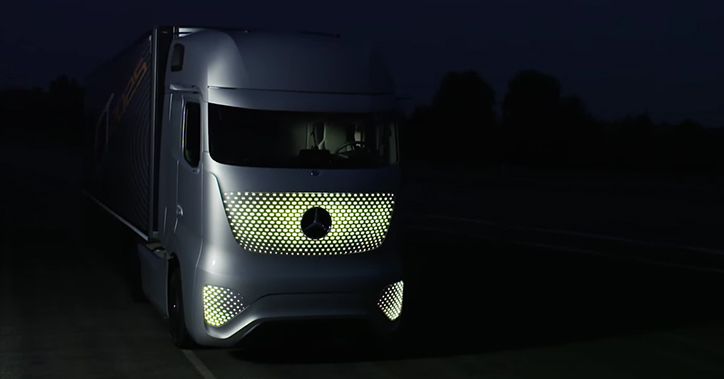23.01.2015
Mercedes-Benz Future Truck
Coming down the road will be thefuture truck of 2025 and it will be able to move autonomously. TheMercedes-Benz Future Truck 2025 was recently showcased at this year'sInternational Commercial Vehicle show (IAA), where visitors got to see what isin store on future highways in terms of trucks, buses and vans. This is animportant commercial vehicle show event, of interest to manufacturers, bodybuilders, suppliers, hauler companies and drivers, in essence the players inthe transport sector. The advantages of such trucks will be greater transportefficiency, safer traffic activity affecting all road users, and fuelconsumption and CO2 emissions further reduced. This will no doubt pleasetransport decision makers who want to see sure signs of transport vehiclesmeeting environmental goals. The Mercedes-Benz publicity literature makes noteof the truck's Highway Pilot system. Comparable to an autopilot in a plane, theradar sensors and dual-camera system of the Highway Pilot make autonomousdriving possible, without relying on any kind of guiding infrastructure. The Pilot can react to a variety oftraffic situations, such as having to move over for approaching emergencyvehicles; there is a Blind Spot Assist to add safety when turning and changinglanes. The company release said that when the drivable vehicle is controlledmanually and on the move, the lights are white. When the truck is drivingautonomously, the color of the lights changes from white to blue. They pulsatestrongly, "symbolizing the truck's powerful heartbeat," and clearlyindicating to other
roadusers of the vehicle's operating mode. As the promotional video also shows, the designreflects a sense of eco-truck where calm rather than clinks and clanks isconveyed. The company noted how elements such as the headlamps seem to bemissing at first glance. "The Future Truck 2025 comes to life when theengine starts. LEDs illuminate the surfaces and light up the paintwork."The promotional video said "This highly intelligent system relieves thedriver from tedious driving as he gains time for other tasks andcommunication." Company information said that when the truck is travellingautonomously, the driver may recline the seat and also turn it by 45 degreesinto the space, allowing a "relaxed, comfortable working position."Indirect lighting illuminates the interior without glare. "In spite of allthis sophisticated technology," said the video, "it is the driver whoremains in charge and in no way will the Highway Pilot replace thedriver."The Mercedes-Benz Future Truck 2025 was also discussedMonday in IEEE Spectrum where Philip Ross noted that a human was behind thewheel just in case. He commented in IEEE Spectrum that "The company haslong been adamant about the continuing need to keep drivers as backup forrobotics and vice-versa. In this
view of automated driving, the point is toeconomize on fuel, improve safety, and give the driver a bit of rest—just notso much that he tunes out altogether." Dr. Wolfgang Bernhard, member of the board, Daimler,made the observation that trucking today involves an environment where drivingcan be boring and monotonous. In contrast, the highway pilot when it takes overnever gets tired and is always 100 percent sharp. It's never angry. It's neverdistracted. All in all, it is safer. Still, self-driving trucks have some yearsto wait before we see them on the road. The biggest part is sorting out asuitable legal environment and once that is in place, the technology can beintroduced. "One of the most interestingquestions on the subject of autonomous driving is the time horizon envisagedfor its realization," said a Daimler discussion of legal requirements andtime horizon for
autonomous driving. "In purely technical terms, turning it intoreality on the roads is already feasible within around five years. This timewindow corresponds to passenger car development
cycles, where apossible start in 2020 is envisaged. Owing to the more complex factors forheavy commercial vehicles, the time horizon will however be rather longer –realistically an implementation is possible within ten years, also in view ofthe legal considerations that still remain to be clarified."
Check this out:
https://www.youtube.com/watch?v=716iniUaR5c
